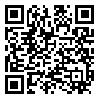

Volume 14, Issue 2 (12-2016)
RBS 2016, 14(2): 137-145 |
Back to browse issues page
Download citation:
BibTeX | RIS | EndNote | Medlars | ProCite | Reference Manager | RefWorks
Send citation to:



BibTeX | RIS | EndNote | Medlars | ProCite | Reference Manager | RefWorks
Send citation to:
صفاري نيا م, باقريان سرارودي ر, علي اكبري م, شاهنده م. The Effectiveness of Psychosocial Therapy and Biofeedback on Improvement of Migraine Attacks and Headache Disability. RBS 2016; 14 (2) :137-145
URL: http://rbs.mui.ac.ir/article-1-458-en.html
URL: http://rbs.mui.ac.ir/article-1-458-en.html
1- دانشيار، مركز تحقيقات علوم رفتاري و گروه روانشناسي سلامت، دانشكده پزشكي، دانشگاه علوم پزشكي اصفهان، اصفهان، ايران
2- دانشيار، گروه روانشناسي، دانشکده روانشناسي، دانشگاه پيام نور، تهران، ايران
3- استاديار، گروه روانشناسي، دانشکده روانشناسي، دانشگاه پيام نور، اهواز، ايران
2- دانشيار، گروه روانشناسي، دانشکده روانشناسي، دانشگاه پيام نور، تهران، ايران
3- استاديار، گروه روانشناسي، دانشکده روانشناسي، دانشگاه پيام نور، اهواز، ايران
Abstract: (3470 Views)
Aim and Background: Migraine is a common neurological disorder characterized by severe and disabling headache usually accompanied with nausea or vomiting, photophobia, and phonophobia, and results in varied levels of disability. Thus, clinicians must consider factors which influence the development, course, and severity of individual headache attacks and subsequent disability in order to minimize the frequency of attacks, reduce their severity, and limit their impact on functioning. Methods and Materials: This quasi-experimental clinical trial was conducted with a 3-month follow-up and control group. The study subjects consisted of 55 patients with migraine who had referred to neurologic clinics of hospitals in Ahwaz, Iran. The subject were selected through continuous sampling and randomly assigned to the 3 groups of psychosocial therapy (n = 20), biofeedback therapy (n = 15), and control (n = 20). Psychosocial and biofeedback therapies were implemented in 8 sessions, each lasting 60 minutes, based on the designed protocol. Data collection tools were a demographic checklist, the Migraine Disability Assessment (MIDAS) questionnaire, and biofeedback galvanic skin response (GSR) system. Data were collected for each group in 3 stages (pretest, posttest, and follow-up). Data were analyzed using repeated measures MANOVA in SPSS software. Findings: The severity of headache attacks in the three stages was significantly different (P < 0.001) in the two groups. A significant correlation was observed between mean severity of the stages and the groups (P < 0.001). Mean headache disability of the three stage were also significantly different (P < 0.001); in addition, there was a significant correlation between mean scores and groups (P < 0.001). Psychosocial therapy showed higher reduction in the severity of migraine attacks and headache disability, compared to biofeedback therapy, and its effects had persisted in the follow-up stage. Conclusions: The findings of this study revealed that psychosocial and biofeedback therapies were effective on improvement of migraine attacks and decreasing of headache disability. However, psychosocial therapy was more efficient in decreasing migraine attacks and headache disability in comparison to biofeedback therapy.
| Rights and permissions | |
 |
This work is licensed under a Creative Commons Attribution-NonCommercial 4.0 International License. |



